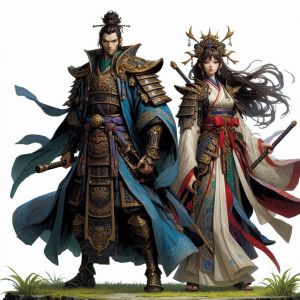Igochians

The Igochians, or as they call themselves, the Ryusei-no Hami, meaning "people of the sun" in the common tongue, are a noble and honorable subrace of humans. They originate from the eastern continent of Igochi. Though it is not unusual to see Igochians in other, far-away lands, the majority of their people are still deeply rooted in their continent of origin.
Igochians hail from a land of rolling steppes, majestic mountains, and serene coastal villages, each region contributing uniquely to the Igochian identity and diversity. The Igochians are a people of contrasts—warriors and poets, farmers and scholars, united by a common heritage, their desire to attain perfection in every aspect of their lives, and an unyielding spirit.
Description
Igochians, on average, are similar in size to other humans, though they tend to be slightly shorter. Women in particular often exhibit a leaner physique. Their skin tones span from light brown to pale white, reflecting the diverse environments of their homeland.
The Igochians predominantly have hair that is either black or dark brown, colors as deep and rich as the ink used in their traditional calligraphy. A rare few are born with white hair, a trait that is seen as a divine blessing, marking them as individuals touched by the heavens. This distinctive feature often brings reverence and respect from their peers.
Their eyes are usually dark brown, like the fertile soil of their homeland, but it is not uncommon to find Igochians with lighter brown, grey, or even the rare and mystical purple eyes. These unique eye colors are often celebrated, thought to signify inner strength and wisdom.
Society

Igochian societies are shaped profoundly by two factors: the surrounding environment and social status.
The varied terrains and environments of Igochi have created a rich and diverse society. The type of land where a particular community exists greatly influences the activities its people pursue and their way of life. It is common for Igochians to form communities around specific activities, such as farming, fishing, or trade. The surrounding environment dictates not only their livelihoods but also their cultural practices and daily routines.
Social status plays a significant role in the daily life of an Igochian. Class barriers between nobles and commoners are distinctly marked, influencing where people live and how they interact. Commoners typically reside in small settlements or on the outskirts of major city centers. They lead simple lives, dedicating themselves to their trades and crafts, fostering a strong sense of community and mutual support.
Nobles, on the other hand, favor the centers of large cities, enjoying more luxurious lifestyles. These urban areas are hubs of culture and power, where noble families often reside in grand homes. Some nobles are esteemed warriors, while others devote themselves to artistic or scholarly pursuits, contributing to the cultural and intellectual wealth of Igochi.
Architecturally, Igochian constructions are relatively simple but exhibit an extreme attention to detail. This meticulous craftsmanship is evident even in common buildings, reflecting the Igochian dedication to perfection. Larger structures, such as palaces and temples, are marvels of architecture and artistic expression, showcasing the society's aesthetic values and engineering prowess. These grand buildings stand as symbols of Igochian heritage, embodying their cultural pride and artistic achievements.